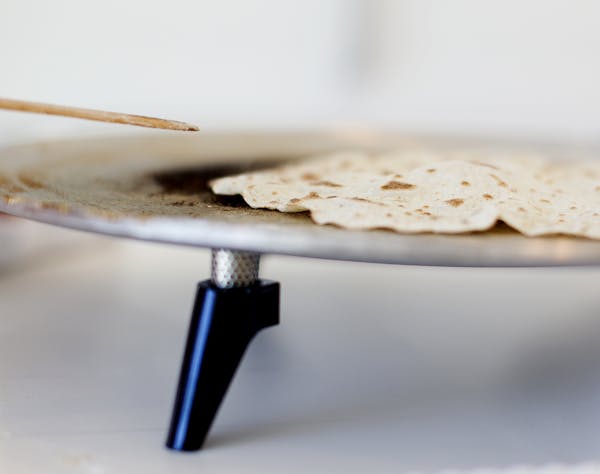Thirty pounds of potatoes. Three pounds of butter. Six cups of heavy cream. Ten pounds of flour.
The Lefse Institute was open.
Rebecca Jorgenson Sundquist slipped a pastry sleeve over a ridged rolling pin. Four griddles were heating up. Pastry boards were covered and sprinkled in flour. Chilled dough awaited on the porch.
She was ready. With ample kitchen space and enthusiasm for heritage, Sundquist had offered her 13-foot counter for lefse making.
The other church ladies of Central Lutheran of Minneapolis were ready, too (well, five of them, including me), aprons in place, in high spirits for their second year of marathon cooking. In six hours we would produce 360 pieces of lefse before collapsing, covered in a dusting of flour. The lacy flatbread would be sold at a holiday bake sale, with proceeds to be donated.
Like tortillas, injera or naan, lefse is a specialty flatbread made of an ingredient always at hand — in this case, potatoes.
In communities with Scandinavian heritage, it turns up on dinner tables from Thanksgiving to New Year's, a kind of holiday version of the Parker House roll. Spread a little butter on the surface, sprinkle it with sugar (white, brown or blended with cinnamon), and roll it up. Then listen for the sigh that follows with the first bite.
There are variations, of course — there always are in the kitchen — since recipes differ from cook to cook, depending on what region your ancestors come from and who happens to pass along a recipe.
Sundquist works with a version from Beatrice Ojakangas, the cookbook author from Duluth, who is of Finnish heritage. It starts with a really good batch of mashed potatoes (that's where the butter and heavy cream come in) with a bit of sugar and plenty of flour. What could possibly be better than that?
Well, there was discussion on one option: adding bacon to lefse. We never really got to the nitty gritty — would that be bacon grease or bacon bits? — before we laughed off the idea.
Plan ahead
The effort starts the night before when the potatoes are prepared: peeled, boiled and drained, as you would for mashed potatoes. Then they are put through the potato ricer, a sieve-like contraption similar to a garlic press or food mill, that pushes the potatoes through tiny holes into rice-like bits, before they will be gently mashed. It's a terrific way to make mashed potatoes anytime, but for lefse, where you don't want any lingering chunks of potato, it's almost a necessity.
Almost is the operative word, as one of our cooks prepared her mashed potatoes without ricing them.
"I couldn't find my ricer," she pleaded (nameless here to protect her lefse reputation).
Those who had used ricers for their dough were unforgiving. "There are lumps in her lefse," a few muttered, perhaps more times than were necessary.
Preparation continues
After refrigerating the mashed potatoes overnight, there is no turning back the next day once the flour is added (as with baking, the amount will depend on the humidity in the air and the moisture in the ingredients).
By now it's real dough, not simply mashed potatoes, and it's gently shaped into golf ball-sized spheres that are soft and supple. We keep them chilled until ready for the griddle.
Each ball of dough is rolled as thin as possible and shaped into a circle. Woe to the lefse maker who isn't attentive.
"Oh, please, that looks like the Taj Mahal," noted one cook to another.
A wooden lifter — a thin, long spatula-like device with a colorful handle — transfers the lefse round from counter to griddle. There the lefse will bubble up, much as a pancake does, while the bottom browns. Then it's flipped to finish on the other side, and set aside to cool.
For Sundquist, her love of lefse connects her to the past. "It's all about our heritage. I learned how from my parents. It evokes so many happy memories. I want to pass this on to my children and grandchildren."
The rolling pins squeak as we prepare one round after another. Griddles overheat after hours at 500 degrees, and a fifth blows a fuse. (Note to host: You need a lefse circuit.)
Our backs ache and our clothes smell of eau de potato when we realize there are another 10 pounds of dough in the refrigerator.
"Time to open the wine," said Sundquist, before we tackled the remaining 120 pieces of lefse.
Last year Becky Forsberg had been a newcomer, a non-Norwegian who married into lefse (never mind that she's Swedish and Finnish).
"Lefse will change your life," Sundquist told her at the time.
"So, did it?" we asked this year.
She just smiled.
Federal appeals court overturns West Virginia transgender sports ban

